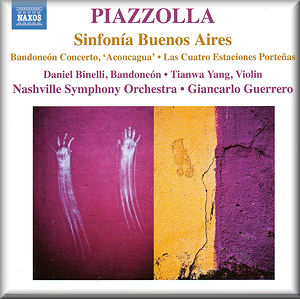 |
 |
|


alternatively
CD: MDT
AmazonUK
AmazonUS
Sound
Samples & Downloads
|
Astor PIAZZOLLA
(1921 - 1992)
Sinfonia Buenos Aires, op.15 (1951) [26:20]
Aconcagua, Concerto for bandoneón, strings and percussion
(1979) [24:58]
Las Cuatro Estanciones Porteñas (1964/1970) [28:20] (arr.
L Desyatnikov)
 Daniel Binelli (bandoneón), Tianwa Yang (violin)
Daniel Binelli (bandoneón), Tianwa Yang (violin)
Nashville Symphony Orchestra/Giancarlo Guerrero
rec. 21-22 November 2009, Laura Turner Concert Hall, Schermerhorn
Symphony Center, Nashville, Tennessee, USA. DDD
 NAXOS 8.572271 [79:38]
NAXOS 8.572271 [79:38] 
|
|
|
It was Nadia Boulanger who said that when writing tangos Piazzolla
was really himself: “Here is the true Piazzolla, “she
said, “do not ever leave him”. Certainly if you
hear some of his early piano works, they are not as representative
of the man as his later work, but what of the early Sinfonia
Buenos Aires? Piazzolla wrote this piece following five
years of study with Ginastera, and it subsequently won a competition
which gave the composer a scholarship to study in France. The
first performance was conducted by Fabien Sevitsky, a nephew
of Koussevitzky, who also administered the competition. He approved
of the vocal opponents to the piece - “this is all publicity”
he told the young composer. A calamitous opening gives way to
a tango of symphonic proportions. There’s a good working
out of the material and the whole makes a very satisfactory
symphonic movement. The slow movement is a hotbed of sexuality
in music and the finale contains some very exciting music but
just isn’t quite up to the standard of the preceding movements.
That said, there’s some very exhilarating and elemental
drumming and blazing brass writing. The orchestration is brilliant
throughout - Piazzolla said that Ginastera made orchestration
“one of my strong points”. It’s a remarkably
robust and positive work, full of colour and rhythm, with memorable
tunes and, for such a young composer, it is amazingly assured
in its intent.
Aconcagua, written nearly thirty years later, is an even
more confident work, displaying the hand of a true master composer.
Like the Sinfonia, there’s a wealth of colour and
energy, with, perhaps, a slight Stravinskian feel to some of
the gestures, but the music is always true Piazzolla. This is
a real virtuoso Concerto in three movements with an accompaniment
which perfectly complements the needs of the soloist - the ability
to sound over the orchestra and sing freely without being engulfed
in a thick background texture. Incidentally, Aconcagua
is the name of the highest Andean mountain.
Piazzolla’s works have been transcribed for many and various
ensembles and combinations of instruments. I have often felt
that Leonid Desyatnikov’s version of Las Cuatro Estanciones
Porteñas (The Four seasons in Buenos Aires) for violin
and string orchestra, which he created for Gidon Kremer, to
be one of the best. This is a nicely fun-packed version for
Desyatnikov includes moments from Vivaldi’s Four Seasons.
Mindful of the fact that Vivaldi lived in the northern hemisphere
and Piazzolla in the southern, in Piazzolla’s Winter
there is a quote from Vivaldi’s Summer. I have
no doubt whatsoever that Piazzolla would have loved this.
The performances are very good, and idiomatic. Binelli is a
fine player and has the spirit of Piazzolla in his playing,
Tianwa Yang has exactly the right swing, and delivers a splendid
performance of this very attractive music. The Nashville Symphony
under Giancarlo Guerrero play to the manner born. The recording
is very good, as one expects from Naxos, and the notes, though
short, are worthwhile. This is a very exciting issue and would
grace any record shelf. It will please all Piazzolla lovers,
and bring many more into the fold.
Bob Briggs
|
|

